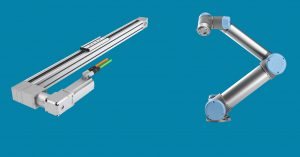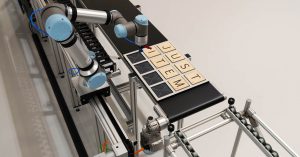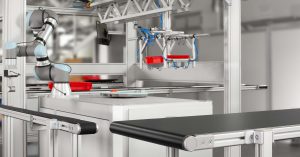When it comes to material flow and related aspects, it’s always important to take a holistic view. The modular item Building Kit System can provide companies with everything they need to make continuous improvements within the context of lean production.
Whether in relation to intralogistics, assembly work benches and the integration of robot solutions, or automation, motion is the element at the very heart of industry and production that holds it all together. It is particularly important to create multiple and diverse links – not only between processes, work benches and areas, but also between humans and robots. The item Building Kit System provides the ideal basis for tackling projects such as those aimed at optimising the flow of materials. Systems can be adapted, extended or disassembled at any time. An interactive multimedia story shows the almost unlimited possibilities that the item Building Kit System offers for every aspect of motion. Thanks to end-to-end compatibility and more than 4500 components for specific areas of application within industry, including conveyor technology, automation, robot integration and ergonomic work bench design, the item Building Kit System offers maximum flexibility – and gets things moving!

Get your production moving
Want to know how to optimise the flow of materials in your company? You can find out even more about the flexibility and possible combinations offered by the item Building Kit System in our interactive multimedia story.
GO TO OUR MULTIMEDIA STORY
Conveyor technology for fast, reliable material flow
In production and logistics, it’s vital that materials and goods get from A to B quickly and reliably. This is where item conveying technology comes in – and the item Conveyor Belt System is right at the heart of it. This is the ideal solution for ensuring goods and materials flow efficiently, with or without accumulation. It combines durability and efficient operations in goods transport with modularity and compatibility with other item product ranges, thus making it possible to create conveyor belt applications that are exactly tailored to the specific transport task at hand. For example, Flat Belt Conveyor 8 40 D is ideal for precisely transporting goods and containers of different shapes. Its asynchronous three-phase AC motor, which is available in two designs, achieves transport speeds ranging from 2.5 m/min to almost 30 m/min.
Both a Double Flat Belt Conveyor and a Double Timing Belt Conveyor are available for transporting dimensionally stable goods and containers.
When transported goods need to be accumulated, use of special belts with low static friction is recommended. Conveyor belts with a high-grip surface ensure goods and containers can be transported safely on conveyor lines with a slope of up to 20°. When heavy goods need to be transported, Timing Belt Conveyor 8 40 D comes into its own, offering many benefits in terms of material flow. Timing belt guide strips keep this conveyor belt on track, while side guides help the timing belt cope with lateral forces. The timing belt is available in an accumulating and a non-accumulating version. Both a Double Flat Belt Conveyor and a Double Timing Belt Conveyor are also available for transporting dimensionally stable goods and containers.
Movement in every dimension – with the item Linear System
Linear technology is called for whenever anything needs to move along an axis. With its modular building kit principle, the item Linear System makes it really easy to put together the ideal solution. The available linear guides include (internal) roller guides, criss-crossed roller guides, T-slot sliders, recirculating ball guides, ball-bearing guide bushes and C-rail systems with a roller guide. When it comes to drives for the item Linear System, the choice ranges from timing-belt drives and rack drives to ball screw drives and chain drives. The free item MotionDesigner® software makes it much easier to select and design the right automation solution. This linear technology configurator takes next to no time to sift through thousands of possible options and select the perfect combination of linear unit, gearbox, motor, controller and accessories. item MotionSoft® commissioning software is used next. Ready-to-install linear units are also available – turnkey solutions that are optimised in terms of speed, payload, precision and stroke length.
Single-axis linear units can be used to transport goods for loading once they have been manufactured and to flexibly move heavy production equipment and robots to the next place they need to be used.
The item Linear System serves as a basis for single axes, synchronous axes, and two-axis and three-axis gantries. This opens up a wide range of possible applications. For example, single-axis linear units are often used in production to carry out tasks such as drilling holes or screwing parts together at several points along a line. Tools such as drills or screwdrivers can be precisely positioned using a single-axis Linear Unit LRE 8 D25 120×80 ZU 80 R50. What’s more, single-axis linear units can be used to transport goods for loading once they have been manufactured and to flexibly move heavy production equipment and robots to the next place they need to be used. 2D gantries serve as the basis for guiding objects such as print heads, nozzles, sensors and scanners. XY tables are ideal for processes such as sorting and filling and for moving heavy tools. Cantilever axes are used for carrying out material and load tests. Three-dimensional processes, such as stacking, palletising and sorting tasks, are carried out with 3D gantries.
Easing physical strain from movement at the work bench – and optimising material flow
While it may not be quite as obvious as in the case of intralogistics or linear technology, movement is also vital at a production work bench. It all starts with the height adjustment of the benches, and the ergonomic item Work Bench System lets you raise and lower the bench electrically, too. This means staff can not only choose the height that suits them best, but also switch easily between sitting and standing. As a result, they don’t have to spend hours at a time in the same position – something that quickly leads to tense muscles and can cause chronic health conditions in the long term. Another benefit of a bench with an electrical height-adjustment system is that personal height settings can be saved and selected directly, such as at a shift changeover. Needless to say, the right kind of movement is also a big part of ergonomics at work benches in manual assembly facilities. The item Work Bench System features special components that ensure awkward movements can be avoided when picking materials and tools and help factor in every employee’s reach – which varies from one person to the next. Parts Containers (for picking small parts) and Trays for holding crates, workpieces and tools can be attached to Pivot Arms, for example, as can Hooks, Holders and Containers for stowing tools.
SystemMobiles L transport trolleys have been specially developed for direct parts picking at the work bench.
If you take a wider view, the question that then arises is how best to interlink work benches and get materials to them. Here, too, item gets things moving in manual production. SystemMobiles L transport trolleys have been specially developed for direct parts picking at the work bench. They can be used to position working materials within easy reach of employees, who can then pick what they need quickly and ergonomically. Three further SystemMobiles are available for other transport tasks. Roller Conveyors are the perfect solution for interlinking several work benches, as they transport production parts between two work benches with speed and precision. Companies can also use Karakuri/LCA (= low-cost automation) to specifically optimise their flow of materials. This alternative, sustainable and cost-effective automation method generally relies solely on spring force, gravity and lever principles. While Karakuri/LCA systems take care of moving around containers, for example, employees can focus completely on tasks that add value and the continuous improvement process (CIP) of lean production.
Integrating robotics into processes – with flexibility and, above all, mobility
Even from a distance, robots of all kinds are an impressive sight as they repeat their precise movements, seemingly endlessly. The item Building Kit System for robotics solutions offers a myriad of options for their seamless integration. While conventional industrial robots are surrounded by enclosures and guards, collaborative robots (cobots) are specifically designed to work in close proximity to their human colleagues. Human employees work in direct interaction with cobots or, at the very least, share the same space. The cobots can also be surrounded by a partial enclosure or an enclosed robot cell if this is necessary for particular processes such as laboratory tasks or welding work, for example. By contrast, other areas of application may require mobile solutions for cobots that need to work hand in hand with humans. For instance, a cobot on a mobile robot column can be moved from one place to another as needed. These kinds of robot columns based on item solutions are used for a variety of tasks, including palletising. For example, a cobot on a robot column could be positioned at an item conveyor belt and palletise the packages that arrive. Mobile robot islands, which correctly position the cobot for machine loading, for instance, offer similar flexibility.
Superstructures for AMRs and AGVs, plus unlimited possible combinations
When it comes to optimising intralogistics and material transport, industry is also increasingly turning its attention to the use of mobile robots. Autonomous mobile robots (AMRs) and automated guided vehicles (AGVs) provide reliable options for automating transport tasks. The item Building Kit System also offers companies ideal solutions for integrating AMRs and AGVs. item profile technology is used to create basic frames and customised racks. Thanks to the end-to-end compatibility of the item world, a cobot solution can also be combined with Karakuri/LCA. Creativity knows no bounds here, as is also clearly illustrated by a student project called “Range Extender”. This involves a linear axis running parallel to a six-metre-long flat belt conveyor. Mounted on this linear axis is a cobot, which has a seventh axis as a result of the superstructure. The cobot is therefore able to rearrange puzzle pieces while the conveyor belt is moving. At the end, there is a frame fitted with a roller conveyor to ensure the flow of materials continues directly. “item in motion” sums up all this dynamic movement perfectly!
Want to keep up to date with everything that’s going on in the world of item? Simply subscribe to the item blog by completing the box at the top right.





